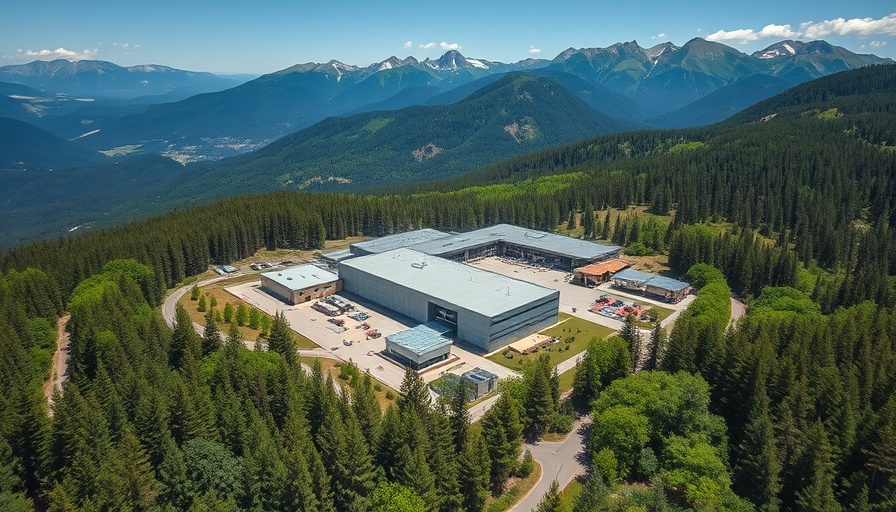
AI Development: A New Frontier for Federal Lands
The U.S. Department of Energy (DOE) has embarked on a bold initiative to accelerate artificial intelligence (AI) technology by opening up federal lands, including the historic Los Alamos National Laboratory, for the construction of data centers. With an emphasis on locations that are not only rich in scientific history but also equipped with vital energy infrastructure, the DOE’s recent announcement sets the stage for a transformational era in tech development on federal grounds.
The Strategic Importance of Federal Lands
Identifying 16 federal sites across the U.S., the DOE aims to leverage the existing electrical infrastructure at these locations to facilitate rapid data center construction. This announcement comes on the heels of a January executive order from outgoing President Joe Biden, aimed at speeding up AI development while promoting renewable energy consumption at data centers. With both nuclear and renewable energy threads running through this initiative, the dual approach underscores the need for sustainable practices in burgeoning tech sectors.
AI's Growing Energy Demands: What to Expect
A report from the DOE highlights a staggering trend: the electricity consumption of U.S. data centers has tripled over the past decade and is slated to double or triple again by 2028, potentially claiming up to 12 percent of the country’s total electricity. The implications of this rise are profound, especially as AI technologies—specifically generative AI and advanced machine learning applications—demand increasingly vast computational resources. As such, the push for data centers on federal land reflects a calculated recognition of these growing needs.
The Nuclear Energy Perspective
An interesting element of the DOE’s approach is its focus on nuclear energy as a cornerstone for fueling these data centers. While the previous administration emphasized a diverse mix of clean energy sources like solar and wind, the current emphasis places nuclear at the forefront. The urgency of addressing climate change, alongside the growing electrification of the economy, suggests that enhanced nuclear power capabilities must be part of the solution to meet both data center energy needs and broader carbon reduction goals.
Political Crosscurrents Impacting AI Development
The development timeline and strategic priorities for federal AI initiatives have become a juxtaposition of legacy policies and evolving political narratives. President Donald Trump’s willingness to uphold Biden’s executive order regarding AI data centers signals an unusual moment in bipartisan agreement—an acknowledgment of the technology's critical importance in the future economy. However, questions remain about how solid this agreement will prove as political tides shift once more and as energy policies evolve.
Addressing Infrastructure Challenges
The construction of AI-centric data centers on federal lands is not without its challenges. Potential roadblocks include regulatory hurdles and environmental concerns related to site selection. Each federal site identified will require a thorough examination of its ecological footprint, local community engagement, and compliance with existing conservation laws. Additionally, technology companies must navigate diverse energy sources to harness the best mix for their operations. The cross-pollination between tech innovation and regulatory frameworks could yield new methods for advancing these goals.
Long-term Visions: What Lies Ahead for AI and Energy
As AI applications proliferate—from chatbots revolutionizing customer service to powerful predictive analytics reshaping industries—the success of this initiative hinges on the collaborative synergy of AI developers and energy providers. To ensure that AI infrastructure thrives sustainably, mechanisms must be established to facilitate liquidity in machine learning and data usage while responsibly managing resources. Making informed decisions today will set the foundation for an AI-infused economy that prioritizes energy efficiency and sustainability.
Final Thoughts on the AI Energy Landscape
The DOE's initiative to invite AI development on federal lands may reshape the tech landscape in ways we are only beginning to understand. While the potential for innovation is immense, it must be balanced with the realities of energy consumption, resource allocation, and political dynamics. Stakeholders across industries must engage critically with these developments as they unfold, ensuring that we are not merely participants but active contributors to a sustainable future.
 Add Row
Add Row  Add
Add 




 Add Row
Add Row  Add
Add 

Write A Comment